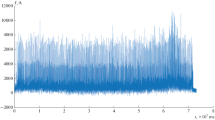Abstract
In modern microprocessor terminals for protecting traction networks, the measured circuit current is converted to a digital signal. There are various automatic techniques of recognizing and classifying digitalized analog signals. The technique that is attracting the greatest interest is the technique of neural networks (NNs), with its high flexibility in differentiating analyzed data. With a sufficient cluster set of learning samples that consist, for example, of operating and emergency current measurements, a NN applied to a traction network can be adjusted to classify the modes observed in the traction network. The integration of this function with the microprocessor terminal for protecting the traction network feeder allows reducing the number of false responses by adapting more accurately to the operational features of the traction power supply system. In the case of changes in the line’s operation conditions—for example, with a change in the type of electric rolling stock—the neural network can be retrained fairly quickly.





Similar content being viewed by others
REFERENCES
Grechishnikov, V.A., Kurov, N.D., and Vlasov, S.P., Emergency control systems in the uninterrupted traction power supply of subways, Russ. Electr. Eng., 2018, vol. 89, no. 9.
Grechishnikov, V.A., Kurov, N.D., and Golitsyna, A.E., False actuation of the protection of the cable feed lines in traction power supply system of subways, Elektron. Elektrooborud. Transp., 2018, no. 6.
Haykin, S., Neural Networks: A Comprehensive Foundation, New York: Macmillan, 1994.
Mackall, D., Nelson, S., and Schumman, J., Verification & Validation of Neural Networks for Aerospace Systems, Mountain View, CA: NASA Ames Res. Center, 2002.
Grechishnikov, V.A., Kurov, N.D., Vlasov, S.P., and Golitsyna, A.E., Determination of electrical parameters of a traction current circuit using measured data in the traction power supply system of an 825-V subway, Russ. Electr. Res., 2019, vol. 90, no. 9.
Author information
Authors and Affiliations
Corresponding author
Additional information
Translated by S. Kuznetsov
About this article
Cite this article
Grechishnikov, V.A., Kurov, N.D. & Kurov, D.A. Using the Quality Ability of Neural Networks to Determine Emergency Modes in a Traction Network. Russ. Electr. Engin. 91, 546–551 (2020). https://doi.org/10.3103/S1068371220090059
Received:
Revised:
Accepted:
Published:
Issue Date:
DOI: https://doi.org/10.3103/S1068371220090059




